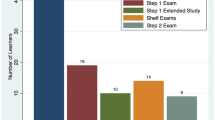Abstract
Medical students will become educators teaching peers, healthcare students, patients, and families. At Rutgers New Jersey Medical School, the “Teaching Assistants in Medical Education” program provides fourth-year medical students with the skills and experiences needed to prepare them as medical educators. The program goes beyond the near peer teaching model to support student development in curricular design, assessment, and communication skills through a Clinical Skills or Anatomy track. Investment in the development of medical students as future educators will yield immediate and long-term rewards.
Similar content being viewed by others
Data Availability
Not applicable.
References
Dandavino M, Snell L, Wiseman J. Why medical students should learn how to teach. Med Teach. 2007;29(6):558–65. https://doi.org/10.1080/01421590701477449.
Nelson AJ, Nelson SV, Linn AM, Raw LE, Kildea HB, Tonkin AL. Tomorrow’s educators… today? Implementing near-peer teaching for medical students. Med Teach. 2013;35(2):156–9. https://doi.org/10.3109/0142159X.2012.737961.
Bene KL, Bergus G. When learners become teachers. Fam Med. 2014;46(10):783–7.
Rees EL, Quinn PJ, Davies B, Fotheringham V. How does peer teaching compare to faculty teaching? A systematic review and meta-analysis. Med Teach. 2016;38(8):829–37. https://doi.org/10.3109/0142159X.2015.1112888.
Ten Cate O, Durning S. Peer teaching in medical education: twelve reasons to move from theory to practice. Med Teach. 2007;29(6):591–9. https://doi.org/10.1080/01421590701606799.
Peluso MJ, Hafler JP. Medical students as medical educators: opportunities for skill development in the absence of formal training programs. Yale J Biol Med. 2011;84(3):203.
Milles LS, Hitzblech T, Drees S, Wurl W, Arends P, Peters H. Student engagement in medical education: a mixed-method study on medical students as module co-directors in curriculum development. Med Teach. 2019;41(10):1143–50. https://doi.org/10.1080/0142159X.2019.1623385.
Onorato SE, Schwartz AW, Beltran CP, Richards JB. Educator with a capital E’: comparing medical education experiences of student-as-teacher elective participants and peers. Med Teach. 2022;44(1):50–6. https://doi.org/10.1080/0142159X.2021.1962831.
Jug R, Jiang XS, Bean SM. Giving and receiving effective feedback: a review article and how-to guide. Arch Pathol Lab Med. 2019;143(2):244–50.
Boud D, Dawson P. What feedback literate teachers do: an empirically-derived competency framework. Assess Evaluation High Educ. 2023;48(2):158–71.
Chowdhury RR, Kalu G. Learning to give feedback in medical education. The Obstetrician & Gynaecologist. 2004;6(4):243–7. https://doi.org/10.1576/toag.6.4.243.27023.
Carless D, Winstone N. Teacher feedback literacy and its interplay with student feedback literacy. Teach High Educ. 2023;28(1):150–63.
Acknowledgements
The authors would like to acknowledge and show appreciation for the 4th-year medical students who have participated in the Teaching Assistants in Medical Education program at NJMS. They have made it a successful program that has improved the educational experience for pre-clerkship students.
Funding
No funding was obtained for this study.
Author information
Authors and Affiliations
Contributions
S.C. initially helped create the Teaching Assistants in Medical Education program. S.C. and C.T serve as co-directors for the Clinical Skills Track and J.G. and G.H. serve as co-directors for the Anatomy Track. J.G. and S.C. primarily wrote the original draft, with G.H. and C.T. reviewing, editing, and adding additional contributions. All authors have read and approved the manuscript.
Corresponding author
Ethics declarations
Ethics Approval and Consent to Participate
Not applicable.
Consent for Publication
Not applicable.
Competing Interests
All authors certify that they have no affiliations with or involvement in any organization or entity with any financial interest or non-financial interest in the subject matter or materials discussed in this manuscript.
Additional information
Publisher’s Note
Springer Nature remains neutral with regard to jurisdictional claims in published maps and institutional affiliations.
Rights and permissions
Springer Nature or its licensor (e.g. a society or other partner) holds exclusive rights to this article under a publishing agreement with the author(s) or other rightsholder(s); author self-archiving of the accepted manuscript version of this article is solely governed by the terms of such publishing agreement and applicable law.
About this article
Cite this article
Grachan, J.J., Holan, G., Traba, C. et al. Moving Beyond the Near-Peer Teaching Model with the Rutgers New Jersey Medical School Teaching Assistant Program. Med.Sci.Educ. 34, 455–461 (2024). https://doi.org/10.1007/s40670-024-01988-z
Accepted:
Published:
Issue Date:
DOI: https://doi.org/10.1007/s40670-024-01988-z




